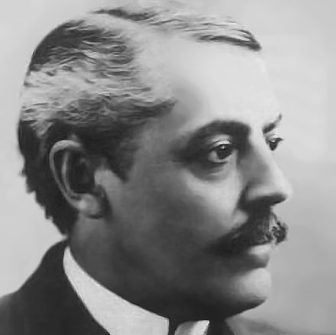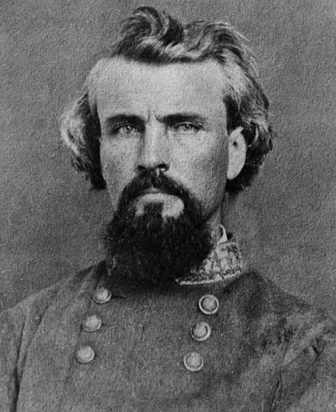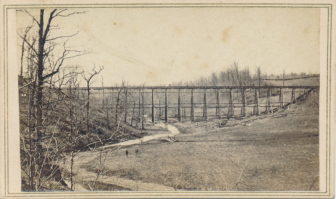Battle of Sulphur Creek Trestle
Battle of Sulphur Creek Trestle Location
The Sulphur Creek Trestle Battle Site is located one mile south of Elkmont, Alabama in Limestone County. The remains of the fort sit just east of the former Nashville & Decatur railroad line which ran north/south. The bulk of the Sulphur Creek Trestle Battle Site is located on private property without public access, the exception being the railroad bed, which is now part of the Richard Martin Trail and is owned by Limestone County.
Battle of Sulphur Creek Trestle Battle Facts
Location: Limestone County, Alabama
Dates: September 25, 1864
Union Commander: Major Eli Lilly
Confederate Commander: General Nathan Bedford Forrest
Forces Engaged: 1,200 Union – 3,500 Confederate
Estimated Casualties: 200 Union – 40 Confederate
Result: Confederate Victory

Colonel Eli Lilly in 1885

Nathan Bedford Forrest

Athens Alabama Battlefield
The Battle of Sulphur Creek Trestle, also known as the Battle of Athens, was fought near Athens, Alabama, in Limestone County, Alabama, from September 23 to 25, 1864.
In September 1864, General Nathan Bedford Forrest led his force into northern Alabama and middle Tennessee to disrupt the supply of William Tecumseh Sherman‘s army in Georgia.
The Sulphur Branch Trestle Fort was originally constructed by the Union Army to defend the strategic trestle bridge across Sulphur Branch Creek on the vital Alabama & Tennessee Railroad.

Sulphur Creek Trestle
This railway was a critical Union line of communication for the transportation of logistics and troops. The fort consisted of prominent earthworks for exterior defense, with 2 blockhouses built in the fort’s interior to provide a secondary means of defense.
On September 25, after defeating Union forces at the Battle of Athens, Confederate cavalry forces under Lt. Gen. Nathan B. Forrest continued a campaign to severely disrupt Union supplies in North Alabama. He attacked the Sulphur Branch Trestle Fort, first engaging Union advance troops. This initial encounter was followed by a sharp artillery barrage against the fort’s interior. During the Confederate artillery assault, the fort’s commander, Col. Lathrop, was killed. The fort’s remaining defenses were eventually overwhelmed, and the remaining defenders surrendered.
After the surrender of the fort, Forrest reported the capture of several hundred troops and 2 artillery pieces. The fort, its 2 blockhouses, and the trestle bridge were burned.
After the engagement at Sulphur Branch Trestle, Forrest continued his campaign of destroying and disrupting other import railway bridges along the Alabama and Tennessee Railroad. Many of the white Union soldiers captured here were sent to Castle Morgan. Castle Morgan, also known as Cahaba Federal Prison, was a prisoner-of-war camp in Cahaba, Dallas County, used to house Union prisoners during the Civil War. The black Union soldiers captured were put to work on the continued construction of Mobile’s defensive earthworks.
Battle of Sulphur Creek Trestle Official Record
The following is taken from The War of the Rebellion: A Comilation of the Official Records of the Union by United States War Dept.:
Forrest, after the capture of Athens, moved with his whole force upon Sulphur trestle. This post was garrisoned by about 300 of the One hundred and eleventh TJ. S. Colored Troops and two pieces of artillery, and was re-enforced on the afternoon of the 24th by about 300 men of the Ninth Indiana Cavalry, under command of Major Lilly, and was afterward still further re-enforced by the Third Tennessee Cavalry, nearly -100 strong, under Colonel Miunis. This regiment left Eogersville ou the approach of Forrest’s force, retreating toward Lawreneeburg, and afterward making their way across Elk River to Sulphur trestle, intending, no doubt, to return to Athens, but were prevented by the appearance of Forrest in the neighborhood of Sulphur trestle. It is not known why LieutenantColonel Minnis did not send a courier to Athens- to notify the commanding officer of the post and myself of the approach of Forrest. Sulphur trestle was surrendered about 11 o’clock on the morning of the 25th,after a very gallant defense, Colonel Lathrop, in command, being first killed, Lieutenant-Colonel Minnis, his successor, struck senseless by a piece of shell, and the ammunition of the command being almost expended. We have received no report of the killed and wounded upon either side of this place. As soon as I ascertained that Forrest had attacked the road in large force 1 reported the same to Major-General Rousseau and Major-General Thomas and asked for re-enforcements. Brigadier-General Starkweather had the posts of Athens, Sulphur trestle, and Elk River bridge under his immediate command, and 1 believe made an effort to re-enforce them and to move there in person. Why he did not I have not yet learned, he having left on leave of absence before rendering his report. Colonel Spalding must have reported to him the presence of Forrest in Middle Tennessee before it was known to me. Every effort, however, was made by me to raise a force in time to relieve the ])ost of Athens from this side. In addition to the force already speciiied,my disposable force here did not exceed 500 men. I immediately ordered Colonel Lyon to send me every available man—at least 1,000 from his command—leaving only ten or fifteen men. to a block-lion.se. Colonel Lyon was delayed in sending on the troops asked for for want of transportation. Major-General Rousseau telegraphed nie on the 24th that on that morning 2,500 men hiid been ordered from Chattanooga to re-enforce me, and that a portion had already started. My little force here was on the cars all night of the 24th waiting the promised support, and we were all ready to start the moment they arrived, with five days’ rations, but no re-enforcements arriving that night nor up to 8.30 a. m.of the25th, I telegraphed to MajorGenerals Rousseau and Thomas, suggesting that the force coming from Chattanooga be -telegraphed at Stevenson to proceed to Pulaski by rail, believing that by this route they would meet the enemy twentyfour or thirty-six hours sooner. I was induced to make this recommendation from the belief that Forrest had by that time destroyed the road or Sulphur trestle and would be at Elk River before the re-enforcenients could reach me; that by the time we could get off from here the enemy would be over Elk River, and would most certainly be at Pulaski before we could reach Elk River, with that river to cross after all the bridges had been destroyed. If these reasonable suppositions were correct (and they have since proven to be so) I could not possibly have come up with Forrest in thirty-six hours, being compelled to march the entire distance over muddy roads cut up with the large force of cavalry and train of the enemy. By the railroad the first detachment of the re-enforcements would have reached Pulaski four hours after they would . reach me, or by 9 p. m. on the 25th, and could have been at Elk River that night by 12 o’clock at farthest, thus saving thirty-six hours. At 5 p. m. the first detachment of re-enforcements arrived at Decatur Junction, 700 strong. Rations were issued to them. At 8.15 p. m. I had given orders for all to move when telegrams from Generals Webster and Rousseau were received to turn back the re-enforcements intended for me and to order them to Nashville. In order to retard the movements of the enemy as much as possible, I telegraphed to General Starkweather to offer every opposition to his crossing Elk River, and to destroy the bridges and ferries along that stream, which I believed at that time to be too much swollen for the enemy to cross with his artillery. What was done by General Starkweather and his forces I have not yet learned, having received no report from troops north of Elk River; and, as General Rousseau moved to Pulaski, I gave- no further orders to troops there, supposing that he had taken them all under his immediate command. Learning that a portion of Forrest’s forces was at Elkton, and that our forces were being strengthened about Pulaski, I felt satisfied that Forrest would move by way of Fayetteville to the Nashville and Chattanooga road, and directed Colonel Lyon to keep a scout in direction of Fayetteville to inform me of his arrival at that place. On the 27th I ascertained positively that Wheeler, with his whole force, had passed through Somerville in the direction of Guntersville. Clanton was reported with 750 men within four miles of Larkin’s Lauding. In consequence of the withdrawal of this portion of the enemy’s force from the immediate vicinity of Decatur, I deemed it no longer necessary to keep so large a force here. I therefore, on the 29th, ordered the Thirteenth Wisconsin Infantry and Eleventh Indiana from this post to Iluutsville, and left for that place myself. I also sent there a section of artillery from this post under escort of a detachment of the Twelfth Indiana Cavalry. Learning that Forrest had passed Fayetteville on the morning of the 30th, I sent a scout in direction of New Market, under Major De Long, who reported early in the afternoon that he had found the enemy four miles from that place in strong force. This fact I reported to MajorGeneral Thomas and requested re-enforcements of 1,000 or 1,500 men, believing the enemy intended coining down on my line of road. At 3 o’clock I sent Colonel Chapman, with 200 men of Thirteenth Wisconsin Infantry, up the road toward Larkinsville, on a train that I had prepared, strengthened with three-inch oak plank, for the purpose of scouting the road. He found the enemy on the road, about live miles out, and drove them off. About 4 p. m. another force of the enemy attacked our pickets on the Pulaski road, and soon after a. flag of truce was sent in by Brig. Gen. A- Buford, with the following communication, addressed to Col. G. M. L. Johnson, commanding post:
Neais Hcntsville, Ala., September 30, 1804.
